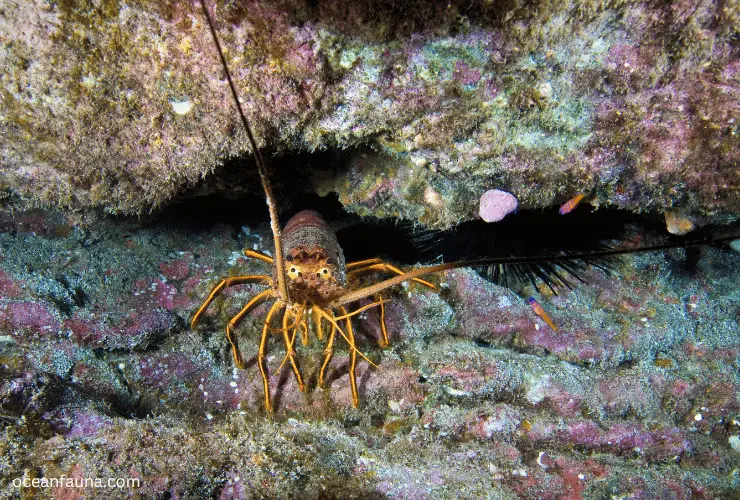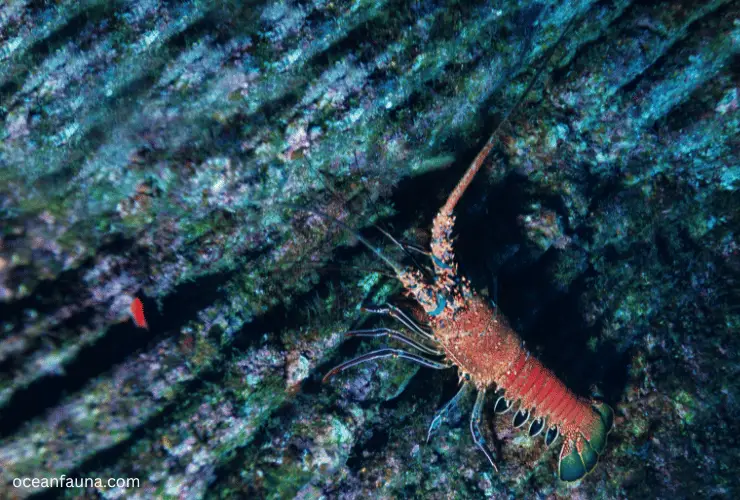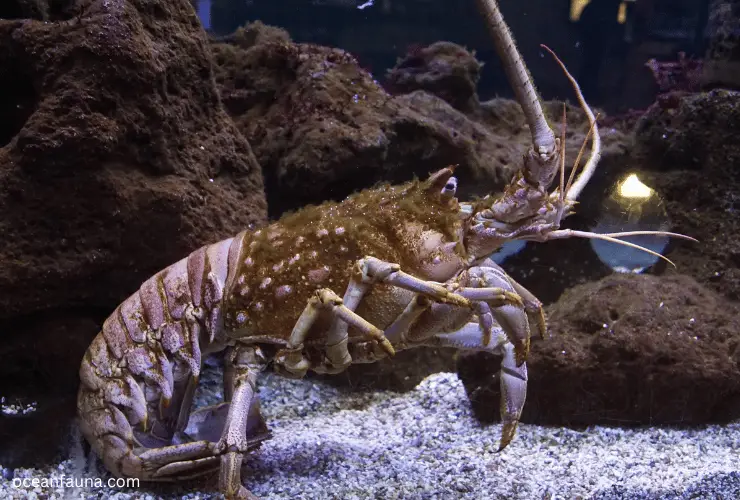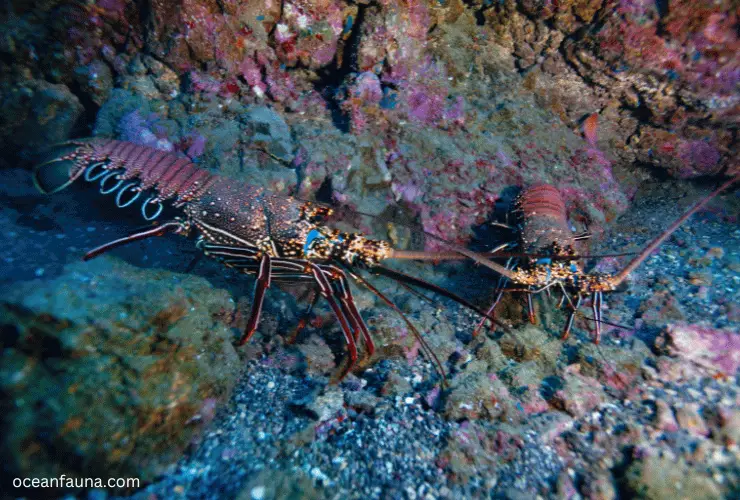Yes, there are lobsters in the Pacific Ocean. However, a few species of spiny lobsters are found there. These lobsters are also known as Pacific lobsters. In this article, I will discuss them in detail.
Which Lobsters Are There in The Pacific Ocean?
People often think that there might be no lobster in the Pacific Ocean. But this is not true. Although most of the lobster species are from the Atlantic, the Pacific Ocean is also home to a diverse group of lobsters, with several species inhabiting its waters. Here, I will discuss the different types of spiny lobsters found in the Pacific.
California Spiny or Red Rock Lobster (Panulirus interruptus)
The California or Red Rock Lobster is one of the most well-known species of spiny lobster found in the Pacific Ocean. It is typically found along the Pacific coast of North America, from California down to Peru and as far out as the Galapagos Islands.
They are a popular seafood item with a delicate, sweet flavor. They have a red-brown shell and long spiny antennae, which they use for defense.
Green Spiny Lobster (Palinuridae)
The Green Spiny Lobster is another species of spiny lobster found in the Pacific Ocean, although it is less well-known than the California or Red Rock Lobster. They are found in the same range as the California or Red Rock Lobster but are less common.
They have a greenish shell and smaller spines on their antennae and are also a popular seafood item with a more subtle flavor than the California or Red Rock Lobster.

Painted Spiny Lobster (Panulirus versicolor)
The Painted Spiny Lobster is another species of spiny lobster found in the tropical reefs of the Indo-Pacific region. They have a mottled pink and yellow shell, which helps them to camouflage in the reefs, and long spiny antennae. They are often used as aquarium species due to their bright colors and non-aggressive behavior.
Jasus caveorum
Jasus caveorum is a species of spiny lobster that was discovered in 1995 on a single seamount in the southeastern Pacific Ocean by fishermen from New Zealand. They are most similar to Jasus frontalis, which is found on the nearby Juan Fernández Islands but are more closely related to species found in the Atlantic and Indian Oceans.
Jasus caveorum are reddish-brown and have long, spiny antennae like other spiny lobsters.
Characteristics of Pacific Lobsters
Pacific lobsters are also called spiny lobsters. As their name suggests, spiny lobsters are known for their spiny, armor-like bodies that help protect them from predators. These crustaceans vary in color, ranging from almost white to a dark red-orange hue.
One of their distinguishing features is the presence of two large, cream-colored spots on the top of the second segment of their tail, which makes them easy to identify.
In addition to their protective spines, spiny lobsters have several other physical characteristics that help them survive in their aquatic environment.
For instance, their powerful legs allow them to swim quickly and evade predators, while their large antennae are used to navigate their surroundings and detect potential threats.
Spiny lobsters do not have claws, unlike the clawed Atlantic true lobsters. This is because they primarily feed on benthic organisms like worms and mollusks that don’t need to be gripped tightly to be captured. However, as opportunistic feeders, they will consume other prey.
Spiny lobsters also have a unique method of reproduction. Males deposit spermatophores (packages of sperm) onto the female’s abdomen, and then she fertilizes her eggs with them. The eggs are then carried on the female’s abdomen until they hatch into larvae.
Another interesting characteristic of spiny lobsters is their ability to migrate long distances for food and suitable habitats. Some populations of spiny lobsters can travel hundreds of miles in a single year.
Why don’t Pacific Lobsters have claws?
Pacific lobsters, also known as spiny lobsters, belong to the family Palinuridae, one of the four major families of lobsters. Unlike the lobsters in the family Homaridae, which are true or American lobsters, spiny lobsters do not have claws.

The reason behind the absence of claws in spiny lobsters is due to their anatomy and evolutionary adaptations. Spiny lobsters have a smooth, hard carapace covering most of their body, making them agile and swift swimmers and protecting them from predators. This carapace is unsuitable for attaching large, muscular claws, unlike the shell of true lobsters.
Moreover, spiny lobsters have developed other means of defense and survival that compensate for the lack of claws. They have a long, powerful tail that they use to propel themselves underwater and escape from danger.
In addition, spiny lobsters have sharp spines on their carapace and antennae that they use as defensive weapons against predators or competitors.
Not all spiny lobsters are completely devoid of claws. Some species within the family Palinuridae have small, non-functional claws that are more like spines or bumps on their legs. However, these claws are not used for grasping or crushing prey like the claws of true lobsters.
What Do Pacific Lobsters Eat?
Pacific lobsters have a diverse diet that mainly consists of sea creatures, including urchins, snails, smaller fish, clams, and mussels. These lobsters use their long, thin legs to catch and manipulate their prey instead of front claws.
The eating habits of Pacific lobsters are fascinating, as they exhibit different feeding behaviors based on the type and size of their prey. For instance, lobsters prey on smaller sea creatures, such as snails and clams, by crushing their shells with their strong mandibles.
Pacific lobsters also prefer urchins, which they eat by flipping them over onto their stomachs and using their legs to pull them apart. They employ a similar technique when feeding on mussels, using their legs to open the shell to access the meat inside.
Pacific lobsters are opportunistic feeders, meaning they are not picky eaters and can consume essentially any edible prey that crosses their path. They mostly feed at night, as it is the time when their prey is most active.
They hunt by detecting the scent of their prey using their chemosensory organs and hide in small crevices to ambush their prey. They are known to be efficient hunters and can quickly capture their prey, even in dark and murky waters.
Why Are There Lesser Lobster Species in The Pacific Than In The Atlantic?
Lobsters are one of the most popular seafood dishes around the world. There are several species of lobsters found in both the Atlantic and Pacific oceans, but the Atlantic is home to more species than the Pacific. This phenomenon has puzzled many marine biologists and seafood enthusiasts, leading to various studies to identify the reasons behind the disparity.
Here are the primary reasons why there are fewer lobster species in the Pacific than in the Atlantic.
Geological Differences
The Atlantic and Pacific oceans are vastly different geologically. The Pacific Ocean is much deeper than the Atlantic and has a more complex geography with deeper trenches, volcanoes, and underwater mountains.
The differences in the geology of the regions have led to variations in lobster habitats. Lobsters thrive in rocky, shallow waters where they can hide, breed, and grow. The Pacific lacks these habitats, and it has fewer favorable environments for lobsters to flourish.
Ocean Currents
Ocean currents play a significant role in the distribution and survival of marine species like lobsters. The Atlantic has a warmer Gulf Stream that originates in the Caribbean, which brings warm water to its eastern coasts. This warmer water creates the ideal conditions for lobsters to breed and survive.
In contrast, the Pacific’s currents are colder and have a higher salt content, making it difficult for lobsters to adapt and survive in such harsh environments.
Overfishing
Overfishing is one of the main reasons why certain species of lobsters are becoming scarce in both oceans. The Atlantic lobster fisheries have been managed better than the Pacific ones.
For example, in the North Atlantic, strict quotas and regulations are in place to safeguard the lobster population.
On the other hand, the Pacific has seen a decline in its lobster population due to excessive fishing pressure, with some species even being pushed to the brink of extinction.
Climate Change
Climate change has been adversely affecting marine life in different ways. The warming of the ocean water has led to changes in the distribution and breeding patterns of fish and crustaceans worldwide.
The Pacific Ocean is one region that has been hit hard by climate change, with rising water temperatures, acidification, and increased ocean pollution. These challenges make it harder for lobsters to thrive and contribute to lesser lobster species in the Pacific.
What Is the Difference Between Pacific And Atlantic Lobster?
Pacific and Atlantic lobsters have several differences in their anatomy and behavior. First, the most noticeable difference is that Pacific lobsters do not have any claws, while Atlantic lobsters possess a pair of strong, crusher claws. This difference is due to evolutionary adaptation to their respective environments.

Moreover, Pacific lobsters have hard shells with longer antennae and spidery-looking legs compared to the Atlantic lobster. These differences are adaptations for survival in their environments. The longer antennae and leg spines protect Pacific lobsters from predators, while the larger claws of Atlantic lobsters help them to defend themselves and capture prey.
Another significant difference between the two species is the taste. The Atlantic lobster is more expensive and has a stronger flavor than the Pacific or other warmer-water lobsters.
Cold water has more minerals, which makes for better-tasting meat. The Maine lobster, which is found in the Atlantic Ocean, gets its rich flavor from the cold, mineral-rich waters of the Gulf of Maine.
Additionally, the habitat and diet of the two species are different. Pacific lobsters are primarily found in the waters of the Western Pacific, from Japan to Southern California. They tend to prefer rocky habitats and consume a diet that includes fish, small invertebrates, and algae.
Conversely, Atlantic lobsters are found along the Eastern coast of North America, from Canada to North Carolina. They inhabit rocky shelves, sandy bottoms, and other habitats and consume a diet that includes clams, crabs, and other marine life.
Can Atlantic Lobster Live in The Pacific?
According to Chris Harley, a marine ecologist at the University of B.C., Atlantic lobsters have occasionally been found in the Pacific.
However, while these lobsters may survive for a little while in the new environment due to their hardy nature, it is unlikely that they would be able to establish themselves and thrive in the Pacific ecosystem.
This is because lobsters are sensitive to water temperature and salinity changes, and the Pacific’s conditions may not be conducive to their survival and growth.
Furthermore, lobsters are highly territorial and prefer specific habitats, which may not be available in the Pacific. For example, lobsters in the Atlantic are known to favor rocky underwater outcrops, while those in the Pacific are often found in kelp forests.
Therefore, the Atlantic lobster’s inability to find a suitable habitat and food sources could hinder their ability to acclimate and thrive in the Pacific.
Also, the introduction of non-native species, such as the Atlantic lobster, can have negative impacts on the native species and ecosystem. This is because they can compete for resources, introduce diseases and parasites, and disrupt the natural food chain.
Thus, it is crucial to monitor the presence of Atlantic lobsters in the Pacific and implement measures to prevent their establishment if necessary.
Conclusion
Hopefully, now you have detailed information regarding the Pacific lobsters. You should not be confused about that; no lobsters exist in the Pacific Ocean.
Although these lobsters are not the same as the Atlantic lobsters, there are some differences in their physiology and behavior. Moreover, overfishing, climate change and other factors have made them rare in the Pacific Ocean.
If you want to know more about them, let me know. I will answer them in detail.


5 thoughts on “Are There Lobsters in The Pacific Ocean?”